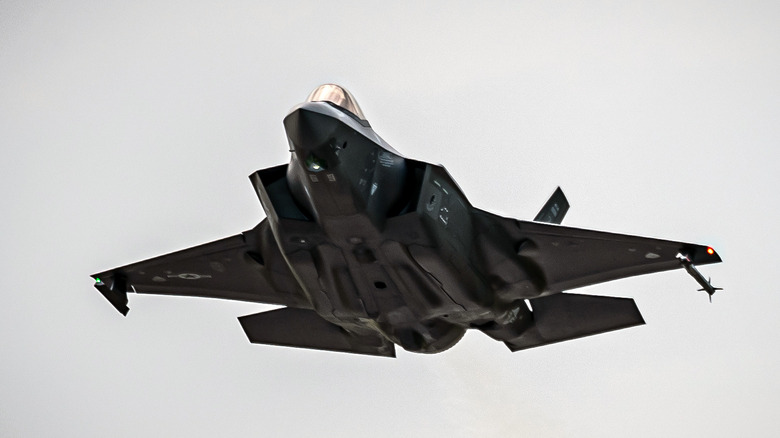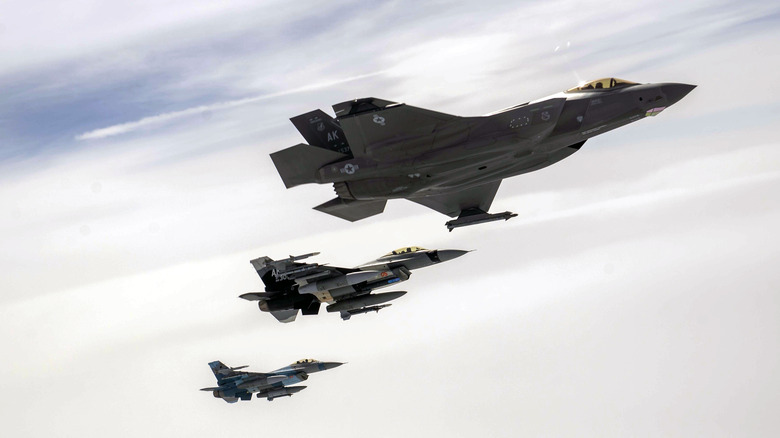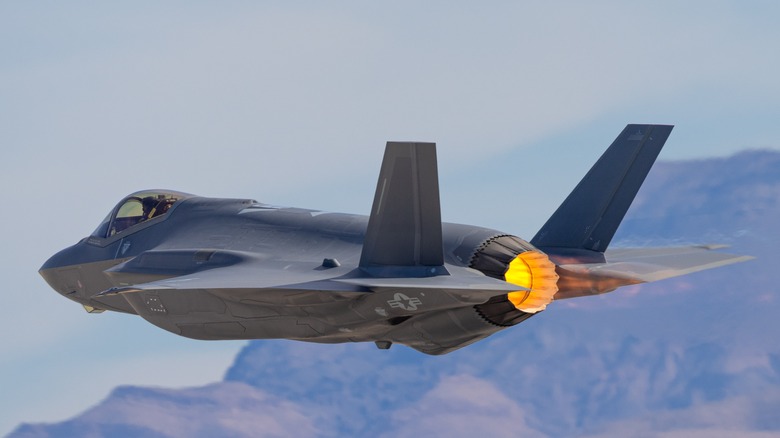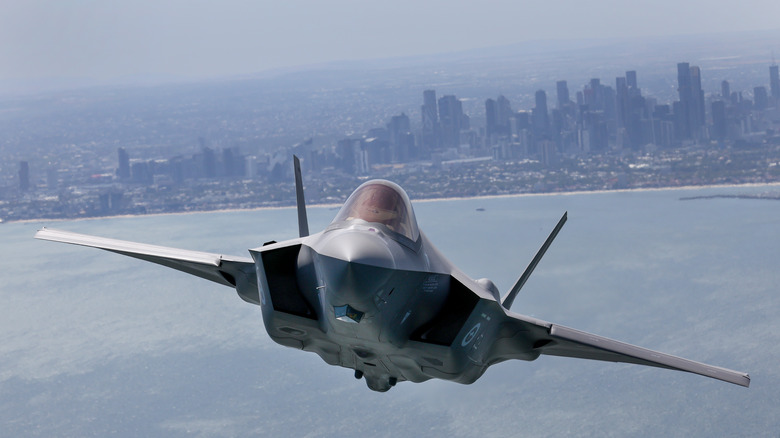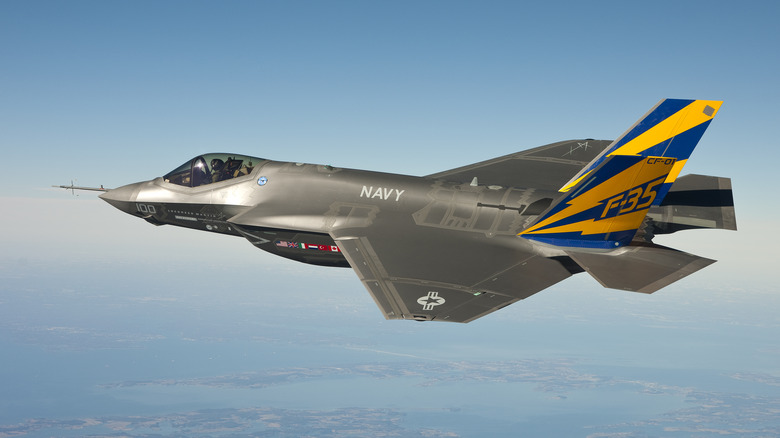How The F-35 Stands Out: A Deep Dive Into Its Speed And Range Capabilities
Like it or not, the F-35 Lightning II is going to become one of the main fighter aircraft of multiple countries with the United States leading the pack. The F-22 may be more deadly, but the F-35 is one of, if not, the most advanced fighting aircraft in the world today. While the plane itself was made famous by its recent wanderings in South Carolina, the story of the F-35 is much older than it may seem at first glance. It may be the emblematic fighter of the 21st century, but the F-35 can trace its roots back to 1997 when its creator, Lockheed Martin, was selected by the Department of Defense to compete in a bid for the Joint Strike Fighter concept.
But, not unlike the world of cars, it took a few years for a concept to become reality. October 24th of the year 2000 marked the first ever test flight of the X-35A prototype. The vertical landing prototype, the X-35B, demonstrated its ability to hover in 2001. It was these test flights that allowed Lockheed Martin to win the contract to build what would eventually be the F-35 Lightning II. It wouldn't be until 2011 that the United States Air Force would officially adopt it.
A multirole fighter
There's no doubt that modern planes like the F-16 Fighting Falcon, F-18 Hornet and Super Hornet, Eurofighter Typhoon, and A-10 Thunderbolt are capable planes, but the F-35 was made to eventually replace all of them. It's designed to fight in the air and be as nimble as the F-16, take off from a carrier like the F-18, provide close air support and provide anti-armor cover like the A-10, and serve as the backbone of friendly nation's air forces like the Typhoon.
The Lightning II, despite being deficient in real-world combat experience, sets out to accomplish this feat by being the best all-rounder. It isn't necessarily the fastest jet out there. But its strength comes from the diversity of the F-35 lineup and how it can be outfitted to perform wherever it's needed. It's not constrained to one role or one combat job. It can act as a spy plane, a traditional fighter jet, or a bomber.
Quick and stealthy
At the heart of every F-35 is a Pratt and Whitney turbofan engine that produces 43,000 pounds of thrust, An F/A-18 Super Hornet may make close to that amount, clocking in around 34,000 pounds of thrust, but it requires two engines to do so. The Lightning II only needs one. The same can be said for the Eurofighter Typhoon. Its two engines generate around 40,200 pounds of thrust combined.
The F-35's massive engine allows it to reach a speed of higher than Mach 1.6 (or about 1,185 miles per hour). Although still astonishingly fast, the F-22 Raptor and Eurofighter Typhoon are faster, reaching speeds of Mach 2 (around 1,480 miles per hour). However, despite the slight deficiencies in speed compared to other contemporary aircraft, the F-35 more than makes up for it with stealth abilities.
Exact specifications are, of course, classified, but, according to Lockheed Martin, the F-35 has an "unmatched" ability to elude enemy radar and surface-to-air missile installations. You don't really need to outrun a missile system that can't see you in the first place. Additionally, weapons can be carried internally on the F-35 meaning that the non-stealth coatings of its missiles and bombs are in no danger of betraying the Lightning II's clandestine activities.
Going beast mode
Speaking of weapons, the F-35 can carry a lot on the inside and outside, 18,000 pounds worth of either missiles or bombs. The exact composition of said armaments varies, but it's reported to carry AIM-9 Sidewinder missiles, AIM-120 air-to-air missiles, JDAM bombs, and an internal 25-millimeter cannon in case things get hectic. 18,000 pounds of weapons is the normal capacity of the F-35, but in 2021, it was revealed by the Royal Australian Air Force that the jet is capable of going "beast mode" and carrying 22,000 pounds of nastiness. It's more than likely that given the general classified nature of the exact combat abilities of the Lightning II, there is more to learn.
Bombs and missiles may be great for knocking out targets in physical space, but the 21st century has propelled the combat space into the electronic realm. And the F-35 is ready. Not only can it provide extremely detailed battle information to forces on the ground, it can seamlessly work with drones to get a literal bird's eye view of the battlefield. If something is happening within the F-35's airspace, it will know about it and act accordingly.
The F-35 is also capable of acting on the offensive in electronic warfare as it's equipped with modules to enact electronic warfare and jam signals. An enemy can't fight with equipment that's been turned off.
Able to do whatever's needed
The F-35 is functionally three aircraft: the F-35A, F-35B, and F-35C. All are made for different combat theaters and in some cases, entirely different branches of the military. The F-35A is operated much like any other fighter jet. It's designed to take off and land on normal runways. Lockheed Martin notes that of the more than 965 Lightning IIs that have left the factory, the F-35A is the most common.
The F-35B is likely the most well-known given its ability to redirect thrust downward via a swiveling engine nozzle and hover in place. This allows it to land just about anywhere, or if the need arises, use its weapons more precisely. Lastly, the F-35C is the aircraft carrier variant. It's the first stealth fighter used for carrier operations. Depending on the variation, it has a range of more than 1,200 nautical miles (1,380 miles) and a combat range exceeding 590 nautical miles (678 miles). Again, specifics are hard to pin down with so much classified information.
